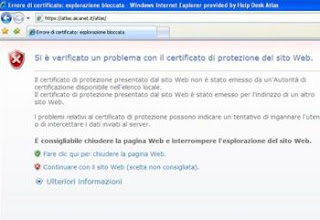 Sometimes, when opening a website, the browser may display this error / warning message: "There is a problem with the website's security certificate".
Sometimes, when opening a website, the browser may display this error / warning message: "There is a problem with the website's security certificate".You can then decide to continue visiting the site or to exit, but what is the meaning of this message?
To explain it, let's see some brief notion of website security, which is important to know in order to be able to easily recognize when to raise the level of attention.
ALSO READ: Safe surfing on a public, free or unsecured wifi network
When you access a website where you need to log in and manage an account, the information that is transmitted, including the password, must remain illegible to those who administer the site and to those who can intercept the traffic.
The provider of the online service could be the bank, an online shop, PayPal, e-mail, where confidential and sensitive data are stored.
When you access this type of site, you will notice that in front of its internet address, there is a padlock and that the URL starts with https:// instead of with http://.
HTTPS (HyperText Transfer Protocol Secure) indicates that the site is protected by Secure Socket Layer / Transport Layer Security.
In practice, it guarantees that the data passing between the visitor and the site is encrypted and that the site is identified as authentic.
The site proves to be administered and managed by its real owners through a security certificate that is recognized by the Internet browser.
If you browse a site which requires registration and registration of an account, but it does not show a security certificate and does not start with HTTPS, then you should pay close attention because the data sent through that site can be readable in clear text.
The same attention should be paid if the site has the https address, but a security certificate problem warning because that could be a fake or otherwise not a safe site.
So when the padlock does not appear green, you can click on it to see more details. In the details are listed the permissions granted to that site, which are explained by Google on this page in the country.
READ ALSO: What to do if a site is "unsafe" in Chrome and what that means
The security certificate of an online store or sites with an https connection is paid by a body called Certificate Authority (CA) that verifies the authenticity of the company and its operations on the internet. Browsers like Google Chrome, Firefox, and Edge look at lists of trusted certificate authorities and display the sites' security certificate. If the certificate has not been updated (because the certification must be renewed every year) or if it comes from an untrusted certification authority, the warning message appears. It may also be that that site, albeit in good faith, has relied on a free certification authority (such as CAcert), which does not have the same levels of recognition and only provide encryption for the site.
Then, if a warning about the website's security certificate is displayed, first of all click on the button to see in detail the reason for the problem. You can then decide whether to continue visiting the site which can be absolutely legitimate and safe or even a fraudulent site.
If the security certificate was revoked o was not considered reliable, it means that the site is not trustworthy or, worse, that it is a phishing attempt.
If the certificate has expired However, before blaming the site, it is worth checking the date in the computer clock and making sure it is correct.
Se on Internet Explorer all or many sites in HTTPS gave that security message relating to the certificate, it may be that the fault lies with the browser on which the list of trusted certifiers is missing.
To install it, go to this support page to find a solution or install the certificate list from here.
ALSO READ: Browse https on all sites


























